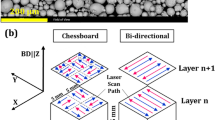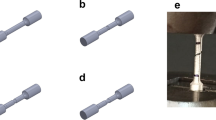Abstract
In order to reveal mechanisms of the shock compaction process for metallic powders, a shock recovery experiment for equiatomic NiTi alloy powder was performed using the flyer plate impact technique, and the microstructure at the central region of the sample after the shock treatment was observed under a metallurgical microscope. It is clearly confirmed from the microstructures that the powder is compacted by three mechanisms: (1) generation of a molten metal jet and its trapping, (2) dynamic friction between powder particles, and (3) plastic deformation around a void. The microstructure of the shock-compacted powder depends on the range of particle dimensions, which implies that the compaction process based on the above mechanisms is influenced by the powder particle size and its distribution. At the periphery of the sample, two structural features are observed. One, which is characterized by the large melt pool and the marked deformation and breakage of the powder particle, is located near the sample region to which a plane shock wave propagates through the sample capsule. The other shows the long melt band along the bottom and the side of the sample. These features are attributable to a shock wave with a nonuniform shock front and a radial shock wave, respectively.
Similar content being viewed by others
References
P. C. Lysne andW. J. Halpin,J. Appl. Phys. 39 (1968) 5488.
R. R. Boade,ibid. 39 (1968) 5693.
B. M. Butcher andC. H. Karnes,ibid. 40 (1969) 2967.
R. R. Boade,ibid. 41 (1970) 4542.
D. Raybould,J. Mater. Sci. 16 (1981) 589.
W. H. Gourdin,J. Appl. Phys. 55 (1984) 172.
W. H. Gourdin andS. L. Weinland, in Proceedings of the American Physical Society Topical Conference on Shock Waves in Condensed Matter, Sante Fe, New Mexico, July 1983, edited by J. R. Asay, R. A. Graham and G. K. Straub (Elsevier, New York, 1984) p. 99.
R. B. Schwarz, P. Kasiraj, T. Vreeland Jr andT. J. Ahrens,Ada Metall. 32 (1984) 1243.
W. H. Gourdin,High Energy Rate Fabr. (1984) 85.
D. G. Morris,Met. Sci. (June) (1980) 215.
Idem, Mater. Sci. Engng 57 (1983) 187.
R. L. Williamson andR. A. Berry, in “Shock Waves in Condensed Matter”, edited by Y. M. Gupta (Plenum, New York, 1986) p. 341.
H. Matsumoto, K. Kondo, S. Dohi andA. Sawaoka.J. Mater. Sci. 22 (1987) 581.
H. Matsumoto, K. Kondo andA. Sawaoka,J. Jpn Inst. Metals 52 (1988) 810 (in Japanese).
Author information
Authors and Affiliations
Rights and permissions
About this article
Cite this article
Matsumoto, H., Kondo, K.I. Various microstructures suggesting possible shock compaction mechanisms. J Mater Sci 24, 4042–4047 (1989). https://doi.org/10.1007/BF01168971
Received:
Accepted:
Issue Date:
DOI: https://doi.org/10.1007/BF01168971




